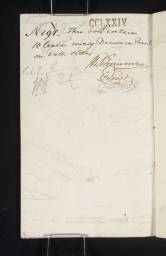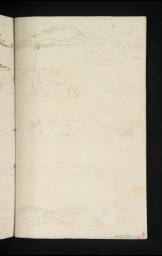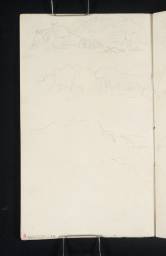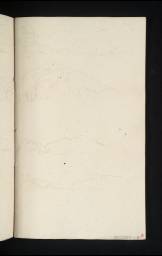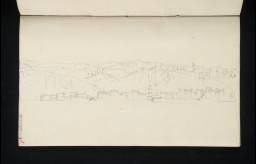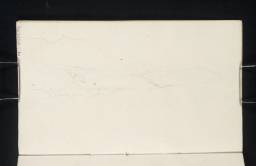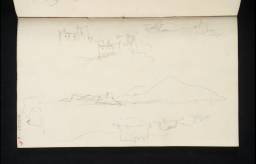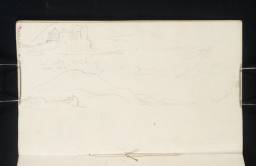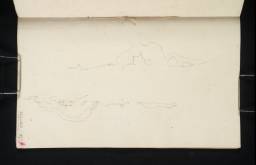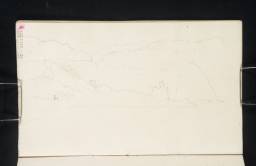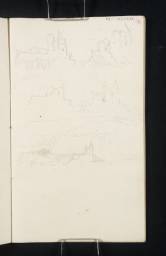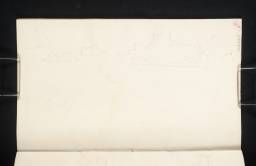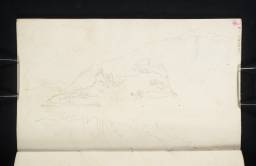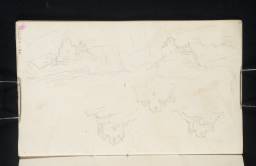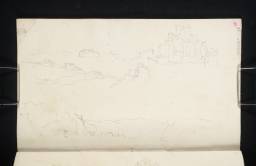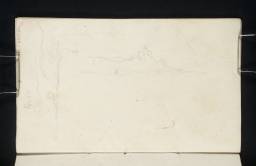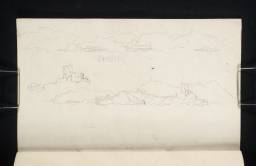Turner Bequest CCLXXIV
Small pocket-book, with pink and grey marbled paper covers.
10 sheets of unwatermarked off-white wove paper by an unknown maker. Approximate paper size: 91 x 153 mm.
Numbered ‘191’ as part of the Turner Schedule in 1854 and endorsed by the executors of the Turner Bequest on the inside front cover (D41019).
10 sheets of unwatermarked off-white wove paper by an unknown maker. Approximate paper size: 91 x 153 mm.
Numbered ‘191’ as part of the Turner Schedule in 1854 and endorsed by the executors of the Turner Bequest on the inside front cover (D41019).
Accepted by the nation as part of the Turner Bequest 1856
Exhibition history
References
The Sound of Mull no.1 sketchbook was one of twelve sketchbooks that Turner used during his 1831 tour of Scotland, which he made to collect views to illustrate Sir Walter Scott’s Poetical Works (see Tour of Scotland for Scott's Poetical Works 1831 Tour Introduction). This pocket notebook was probably bought in Scotland and was not opened until Turner reached Oban on the west coast. By this time he had already visited the Cumbrian Lakes, and the western and eastern Scottish Border Country, stayed with Scott at his Abbotsford home, and gone to Edinburgh, Stirling, the Trossachs, the western lochs and Islay (see Tour Introduction). The present sketchbook was used during his journey by steamboat along the Sound of Mull to Skye. After exploring the island, Turner visited Mull and Staffa before returning to Oban to begin his journey up Loch Linnhe to Balloch and Glencoe, onto Fort William, and then to Fort Augustus via the Caledonian Canal, and onto Inverness. From there he continued north to Evanton, then north-east to Elgin and across to Aberdeen, the final stop on his two-month tour.
The Sound of Mull no.1 and similar Sound of Mull no.2 sketchbook (Tate D26955–D26965; D41021–D41022 complete; Turner Bequest CCLXXV) have often been dismissed by scholars such as Gerald Wilkinson as ‘nothing but penny notebooks – with nothing much drawn in them.’1 Indeed, John Ruskin’s assessment on the wrapper of the present sketchbook (no longer with the book) – ‘valueless, or nearly so’ –2 has remained the critical consensus. David Wallace-Hadrill and Janet Carolan, however, in their unpublished article on Turner’s visit to Skye, have taken issue with Ruskin, arguing that the books are ‘far from valueless in the context of Turner’s itinerary after leaving Oban.’3 While the present writer doubts some of the authors’ identifications, the information that they have gleaned about Turner’s route to Skye is invaluable.
Gerald Finley, in his book on Turner’s illustrations to the work of Sir Walter Scott, has commented that ‘many westerly subjects that were considered for [Sir Walter Scott’s] The Lord of the Isles are included in the two “Sound of Mull Sketch Books”.’4 Two early suggestions considered by Scott and his publisher Robert Cadell, but later dropped, were ‘Mull Sound’, sketched on folios 3 verso–inside back cover (D26941–D26954, D41020) and Ardtornish Castle (‘Artornish’) on folios 9–9 verso (D26951–D26952), though with no sign of the ‘thunderstorm’ that Scott requested.5 The identification of the sketches in the two Sound of Mull sketchbooks therefore prove that Turner was indeed on the lookout for suitable subjects to illustrate Scott’s Poetical Works when he steamed from Oban to Skye.
The Sound of Mull no.1 sketchbook contains only ten pages which Turner filled with rapidly executed sketches recording his departure from Oban and the crossing of the Firth of Lorn (inside back cover–folio 3; D41019, D26936–D26940), and his journey up the Sound of Mull. This was the first stage of his tour around the islands of Skye, Mull and Staffa. Having filled the sketchbook, Turner opened the Sound of Mull no.2 sketchbook and continued sketching the rest of his journey to Skye.
It is clear from the subjects depicted and the style of execution that Turner was not on the lookout for picturesque views and ready-made compositions during his journey up the Sound of Mull. His sketches are rough and rapidly executed, and tend to be of architectural and topographical details rather than entire vistas, constituting visual notes rather than drawings that could be worked up into finished pictures.
The majority of the sketches are of the castles that line the Sound of Mull on the shores of Morvern to the north and the Isle of Mull to the south. These structures, in various stages of ruin in 1831, have little architectural interest, though in their ruined states, with their desolate settings and their sentinel positions perched on rocks and headlands, they could be regarded as rather picturesque. Their greatest interest to the traveller or tourist, however, is likely to be historical, and Turner’s small, matter-of-fact studies, often crowded together on the page, and with few details beyond the basic structure of the ruins and their immediate setting, suggest an antiquarian rather than artistic approach. Turner’s approach differed slightly on his return journey along the Sound of Mull to Oban, which is documented in slightly more finished sketches in the Staffa sketchbook (Tate D26839; Turner Bequest CCLXXIII 50a).
Turner’s immediate priority in Scotland in 1831 was to collect views for Scott, and his explorations of Skye, Mull and Staffa are all connected to the illustration of Scott’s poem, The Lord of the Isles. When Turner met Scott and Cadell at Abbotsford, nearly a month before his visit to the Western Isles, the artist, author and publisher discussed various subjects to illustrate the forthcoming edition of Scott’s Poetical Works. While a note in the front of Turner’s Abbotsford sketchbook, probably made as a result of the meeting, demonstrates that ‘Loch Corisk’ (Loch Coruisk , also called ‘Coriskin’ by Turner) and ‘Staffa’ had been chosen as the subjects for ‘Lord of the Isles’ before Turner left Abbotsford for the west (Tate D40995; Turner Bequest CCLXVII inside front cover), Finley argues that the selection was not confirmed until 17 September, having been regarded as ‘possible’ subjects before this time, with ‘McLeod’s Maidens’ as an alternative to Staffa.6 Although it had now been decided that Turner would travel as far as Skye, the three men were perhaps still mindful that time and the weather might prevent the artist from sketching the preferred subjects, and so Turner’s sketches of ‘Mull Sound’ and ‘Artornish’ (Ardtornish), two subjects that had previously been considered for illustration, may have been partially motivated by the prudent idea of collecting spare or alternative subjects for Scott.
Turner’s interest in the historical associations of the area, however, may have gone beyond Scott’s commission. Of course the artist took the opportunity to sketch other interesting antiquities as he passed them, and this accounts for the sketches of Duart and Aros castles in this sketchbook, and Dunollie Castle in the Staffa sketchbook (see Tate D26928; Turner Bequest CCLXXIII 95). But he also detoured from the most direct route to sketch Scott’s commissions. He visited Gylen Castle on the Island of Kerrera (Tate D26885; Turner Bequest CCLXXIII 73a), and took a much longer detour to visit Islay, where Finlaggan Castle, the seat of the Lords of the Isles, seems to have been the focus of his interest. Turner therefore seems to have taken an independent interest in the history of the Western Isles, especially in connection to the Lord of the Isles. While this was probably stimulated to a large extent by Scott’s poetry and prose, which also inspired countless other tourists, Turner may have been spurred on by references to the subject in contemporary guidebooks such as the Steamboat Companion,7 and by the significance of the area to other works of literature such as The Works of Ossian, 1765.8 As Turner journeyed up the Sound of Mull with his mind on the Lords of the Isles his eye was on the lookout for castles and forts associated with them.
Turner’s choice of sketchbook for this stretch of his journey was entirely appropriate for his purposes. The Sound of Mull no.1 sketchbook is a small, thin and cheap pocket book made up of a few sheets of low-quality unwatermarked paper, probably, as Peter Bower suggests, purchased during his travels rather than brought from London;9 Turner probably had to make do with whatever he could get his hands on. While the sketchbook may not have been ideal, Turner was perhaps mindful of running out of good quality paper, and so saved room in the Staffa sketchbook for landscape views of Skye and elsewhere, using the Sound of Mull books for rough notes. Their small size may also have suited him better while on the deck of a steamboat as they would fit in his pocket, and if it were raining he would not have wanted to spoil a whole book already half filled with sketches. It seems unlikely that Turner would have wanted to preserve the journey to Skye as a distinct group by reserving these two books for it, especially as it disrupted the sequence in the Staffa sketchbook. Therefore the two Sound of Mull sketchbooks could perhaps be seen as notebooks rather than sketchbooks, although with Turner the distinction is perhaps a false one.
David Wallace–Hadrill and Janet Carolan, ‘Turner on the Isle of Skye 1831’, [circa 1991], Tate catalogue files, [folio 4].
The Steamboat Companion and Stranger’s Guide to the Western Isles and Highlands of Scotland, Edinburgh 1831.
The Works of Ossian, 1765, published by James MacPherson, includes the poem Fingal from where Fingal’s Cave on the Isle of Staffa got its name.
How to cite
Thomas Ardill, ‘Sound of Mull No. 1 sketchbook 1831’, sketchbook, March 2010, in David Blayney Brown (ed.), J.M.W. Turner: Sketchbooks, Drawings and Watercolours, Tate Research Publication, December 2012, https://www

